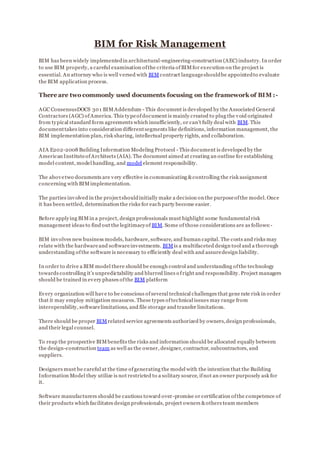
BIM for Risk Management
- 1. BIM for Risk Management BIM has been widely implementedin architectural-engineering-construction (AEC) industry. In order to use BIM properly, a careful examination ofthe criteria ofBIMfor execution on the project is essential. An attorney who is well versed with BIM contract languageshouldbe appointedto evaluate the BIM application process. There are two commonly used documents focusing on the framework of BIM :- AGC ConsensusDOCS 301 BIMAddendum - This document is developed by the Associated General Contractors (AGC) ofAmerica. This typeofdocument is mainly created to plug the void originated from typical standard form agreements which insufficiently, or can’t fully deal with BIM. This documenttakes into consideration differentsegments like definitions, information management, the BIM implementation plan, risk sharing, intellectual property rights, and collaboration. AIA E202-2008 Building Information Modeling Protocol - This document is developed by the American InstituteofArchitects (AIA). The document aimed at creating an outline for establishing model content, model handling, and model element responsibility. The abovetwo documents are very effective in communicating &controlling the risk assignment concerning with BIMimplementation. The parties involved in the projectshouldinitially make a decision on the purposeofthe model. Once it has been settled, determination the risks for each party become easier. Before applying BIMin a project, design professionals must highlight some fundamental risk management ideas to find out the legitimacyof BIM. Some of those considerations are as follows:- BIM involves new business models, hardware, software, and human capital. The costs and risks may relate with the hardwareand softwareinvestments. BIM is a multifaceted design tool and a thorough understanding ofthe software is necessary to efficiently deal with and assuredesign liability. In order to drive a BIM model there should be enough control and understanding ofthe technology towards controlling it’s unpredictability and blurred lines o fright and responsibility. Project managers should be trained in every phases ofthe BIM platform Every organization will have to be conscious ofseveral technical challenges that gene rate risk in order that it may employ mitigation measures. These types oftechnical issues may range from interoperability, softwarelimitations, and file storage and transfer limitations. There should be proper BIM related service agreements authorized by owners,design professionals, and their legal counsel. To reap the prospective BIMbenefits the risks and information should be allocated equally between the design-construction team as well as the owner, designer, contractor, subcontractors, and suppliers. Designers must be careful at the time ofgenerating the model with the intention that the Building Information Model they utilize is not restricted to a solitary source, ifnot an owner purposely ask for it. Software manufacturers should be cautious toward over-promise or certification ofthe competence of their products which facilitates design professionals, project owners &others team members
- 2. associated with the project to easily access to the BIM. All parties must perform mutually to build up new contract forms useful for addressing, allocating, and distributing risk impartially in a clear way. Design changes in a BIM model may resultin enhancing the risk ofdesign and range ofservices. Information along with design elements is provided into the BIM database and the database communicates elements ofa building design. So if a change happens to one phaseofthe design all interrelated designs consequently are reconfigured. The push for applying BIM’s flexibility to create change upon changeright equal to and togetherwith bidding and construction will have to be uncompromisingly controlled and persistently restrained. Although make alteration in BIM is simple, but budgets and design-construction schedules arenot as flexible. Design professionals have to face several quarries while finalizing their design documents. These quarries may range from - What control over the design is to be surrendered to the software providers, contractors, subcontractors, manufacturers, and suppliers?Where should be the line involving the designer-of-recordand the other entities contributing input to the model?Should the designer -of- record express his/her control over the design withouthav ing BIM expertise?Exclusive ofsufficient supervision, is BIMclose to the risks concerning offshore outsourcing? BIM touts its ability to eliminate design conflicts, reduce errors, and limit omissions. But a question remains – will the use ofBIM raise the standard ofcare?Will design professionals using BIM be held to a standard ofcare equal to perfection or something very c lose to it?It will be a long while before there is case law addressing thesequestions. In the short term, designers need to be proactive in defining and reinforcing the concept that the standard ofcarefor BIM-delivered projects as being the same as the standard ofcare for conventionally-delivereddesigns. The BIM users should havesufficient technical and managerial skills toward managing access to all the “pieces and parts,revising &tracking model changes for successfully control model inputs and outputs. Design professionals while delivering BIM-related information to Consultants, contractors, suppliers, and subcontractors, should necessitatean executed disclaimer like those presently utilized together with providing CADDfiles. The risks may also be connected with working across software boundaries in creating design- construction software work. Design professionals find it difficult to handle the design process for sufficientdetailing and quality assurance/control activities. Ifany construction document is issued from a BIM model not highlighting detail and quality reviews properly,may lead to budgetand schedule failures. So designers shouldassign the essential resources to get rid ofthe problems. ~~~~~~~~~~~~~~~~~~~~ Published By Biswajit Kundu www.bimoutsourcing.com ~~~~~~~~~~~~~~~~~~~~